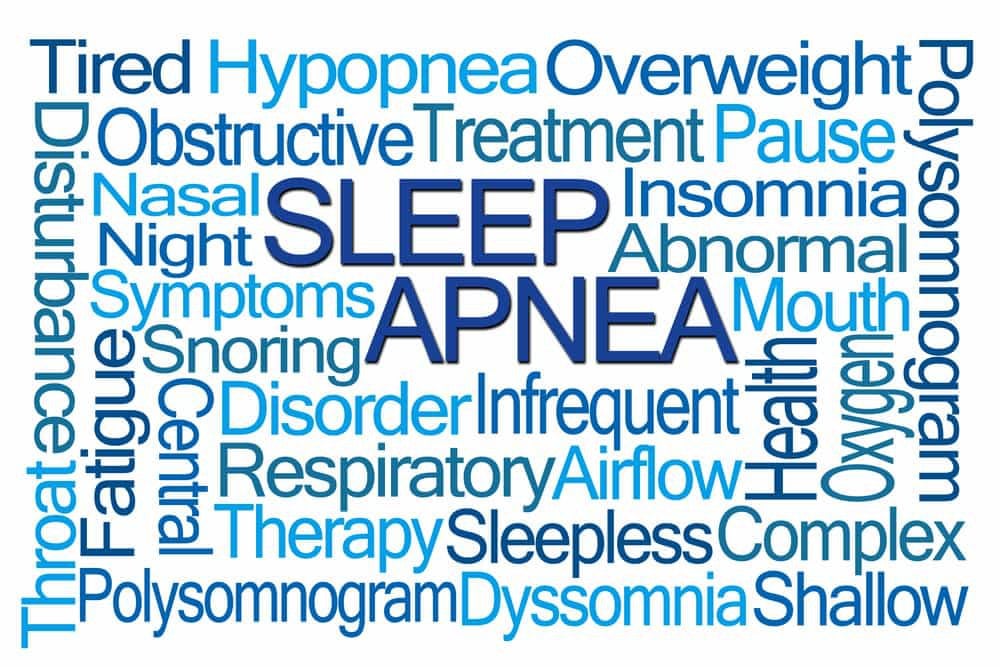Obstructive Sleep Apnea (OSA): Signs, Symptoms, Causes, Diagnosis, and Treatment Options
May 10th, 2022 | 5 min. read

If you struggle with breathlessness during sleep and often wake up during the night gasping for air, you might be suffering from sleep apnea.
Sleep apnea is a significant health concern in the United States. Obstructive Sleep Apnea, if undiagnosed, can lead to chronic heart failure, stroke, high blood pressure, atrial fibrillation, and other cardiovascular problems.
What is Obstructive Sleep Apnea?
Obstructive Sleep Apnea is defined as a serious sleeping disorder that causes breathing to stop and start repeatedly during sleep, causing the patient to wake up from breathlessness.
In OSA, the patient's muscles relax as they fall asleep, collapsing the soft tissues behind the throat, causing a blockage in the airway. The blockage can cause reduced breathing, as in hypopneas, or a total pause in breathing.
The blockage can last for 10 to 30 seconds, while some last for one minute or longer. A pause in breathing can cause an abrupt oxygen reduction in the blood, causing the blood oxygen level to fall to 40% in some cases.
OSA episodes can occur several times at night, causing disrupted sleep and increased daytime drowsiness in OSA patients.
People suffering from obstructive sleep apnea often snore frequently and loudly while remaining silent in times of reduced or blocked airflow. They often make choking, gasping, or snorting sounds when the airways open.
Prevalence of Obstructive Sleep Apnea
Currently, in the U.S., about 22 million people are suffering from sleep apnea, according to the American Sleep Apnea Association (ASAA), while 80% of the moderate and severe sleep apnea cases remain undiagnosed.
In North America, OSA is seen in 15 to 30 percent of males and 10 to 15 percent of females, where the apnea-hypopnea index (AHI) is more than five events for every hour of sleep.
OSA has been reported in a higher percentage in the male population, with the risk increasing with advancing age and obesity.
It is seen more in the African American population below 35 years of age than in White Americans of the same age. Also, the incidence of OSA in Asia is similar to the U.S., even when they have a lower obesity rate.
Want to know if you have Obstructive Sleep Apnea?
Click the image below to request an appointment today.
Signs and Symptoms of OSA
Obstructive Sleep Apnea (OSA) can affect your day-to-day life in a significant manner. People with OSA experience daytime drowsiness and general symptoms of fatigue and lethargy because of lack of sleep resulting from the sleep disorder.
Some of the signs that are common for OSA patients are:
- Breathlessness or disrupted breathing during nighttime, when a person's breathing can become labored or stop completely several times at night
- Daytime drowsiness
- Lack of attentiveness during the day and clouded thinking
- Irritability and mood swings
- General sense of tiredness and fatigue
- Insomnia with frequent awakenings at night
- Morning headaches
- Choking or gasping sensations while waking up at night
- Loud and frequent snoring with gasping, choking, or snorting before briefly waking up
- Nocturia or urge to urinate
- High blood pressure
- Nighttime sweating
- Decreased libido
Causes of OSA
OSA can occur if your airway gets blocked, either partially or totally, because of collapsing of the throat tissues. Some of the factors that can increase the risk of having OSA are as follows:
- Hereditary factors: People who have one or more close relatives suffering from OSA are likely to experience some form of OSA in their lifetime.
- Obesity: Having weight gain issues can increase your risk of having OSA by 60%.According to research, a 10% weight gain can lead to a 32% increase in AHI, while a 10% weight loss can reduce AHI by 26%. A 10% weight gain can result in a six-fold increase in the risk of having moderate to severe sleep-disordered breathing.
- Abnormal hormonal issues: Hormonal disorders like hypothyroidism (underactive thyroid) or acromegaly (excessive growth hormones) can cause obesity in a person or swelling in the airways, increasing the risk of OSA in people.
- Physical characteristics: Certain physical attributes in a person, like the size and position of a person's jaw, neck, tongue, tonsils, shape of your palate, and other tissues behind the throat, can increase the risk of OSA.
- Sleeping position: Certain sleeping positions like sleeping on your back can cause the throat tissues to collapse easier, causing OSA symptoms.
- Nasal congestion: People already having nasal congestion can experience OSA symptoms as their ability to breathe from their nose gets reduced.
- Alcohol and use of sedatives: Increased consumption of alcohol and frequent use of sedatives can relax the throat muscles, increasing the risk of OSA in people.
- Cigarette smoking: Smokers, especially those who smoke heavily, are at an increased risk of experiencing OSA symptoms than nonsmokers.
How to Diagnose OSA
OSA is diagnosed in the following ways, with sleep studies being the most conclusive.
Clinical History:
To diagnose OSA in people, their symptoms are checked using a questionnaire. Although the accuracy of a screening questionnaire can be limited, the STOP-Bang questionnaire is a helpful tool for diagnosing OSA, especially in obese and surgical patients.
Physical examination:
Often a person's anatomical features can make them susceptible to OSA symptoms. Checking for physical characteristics like large neck circumference, high body mass index, and other factors like posterior chin position, narrow oropharyngeal opening, and increased angle between the chin and thyroid cartilage can diagnose OSA in people.
Polysomnography or Sleep Studies
Sleep studies that are performed in a sleep laboratory or at home can help determine the apnea-hypopnea index (HIA), crucial to diagnosing OSA in people.
An AHI of 5 or more events in an hour or five or more events per hour is required to diagnose OSA.
The sleep studies performed are as follows:
Overnight polysomnography:
It is performed in the sleep laboratory and is a first-line diagnostic study conducted in the presence of an attendant. It can be:
- A full night study, generally done for diagnosis of OSA, followed by a study for positive airway pressure titration.
- A split night study is performed where the diagnosis of OSA and positive airway pressure titration is made on the same night. Split night studies are done for patients whose AHI was 20 events or more per hour within the first two hours of study.
HOME SLEEP APNEA TESTS:
These home sleep tests are done at home and typically monitor airflow, respiratory effort, and oxygen saturation. They can be less accurate than the first-line tests in the sleep laboratory as:
- There exists a risk of data loss from detached or malfunctioning monitoring equipment;
- Home apnea tests fail to discern between sleep and wakefulness and can only estimate an AHI index.
Home apnea tests can accurately diagnose the high pretest probability of OSA, ruling out OSA in low-risk patients. However, they are not recommended in patients with a risk of congestive heart failure, neurological conditions, or chronic lung diseases.
OSA Treatment Options
Milder forms of OSA can be treated by making lifestyle changes like losing weight, avoiding alcohol and sedatives, quitting smoking, and having a healthier lifestyle. In contrast, moderate and severe OSA treatment options might include the following:
CPAP Therapy:
With CPAP (continuous positive air pressure), continuous air pressure is provided through oral, oronasal, or nasal devices to relieve OSA symptoms in patients. The air pressure provided is constant and continuous, slightly higher than the surroundings and just enough to keep your upper air passages open.
CPAP is the most used treatment for OSA in people. It can improve the quality of life of OSA patients by lowering their blood pressure, rates of strokes and arrhythmia, and improving cardiovascular events.
For people who cannot tolerate CPAP, BPAP(bi-level positive air pressure) or APAP (automatic positive air pressure) can be considered to provide relief against OSA symptoms.
Oral Appliances:
Where patients cannot tolerate CPAP, oral appliances can provide an alternative treatment for OSA. The two major oral appliances used are:
- Mandibular Advancement Devices: They are devices used to position the patient's jaw forward that help to expand the airway;
- Tongue Retaining Devices: The device holds the tongue in place and prevents it from causing airway blockages.
Surgery:
Doctors may recommend surgery where CPAP and oral appliances fail to treat OSA in patients. Often, surgery is required to correct physical deformities that block the airways causing OSA symptoms.
Removing tonsils, uvula and adenoids can help open up the airways, preventing OSA symptoms in patients.
Inspire Sleep Apnea Therapy:
Inspire Sleep Apnea Therapy can be used as an alternative to CPAP. It is a small device that is placed inside your body during a same-day outpatient procedure. It is an FDA-approved treatment for obstructive sleep apnea that works inside your body with a button click.
Before going to bed, you need to use a remote to turn on Inspire. It keeps your airway open as you sleep, preventing OSA symptoms.
If you or someone you know snores during sleep presents other symptoms of sleep apnea listed above, reach out to Houston ENT& Allergy for an evaluation and discussion of treatment options.
Topics:
